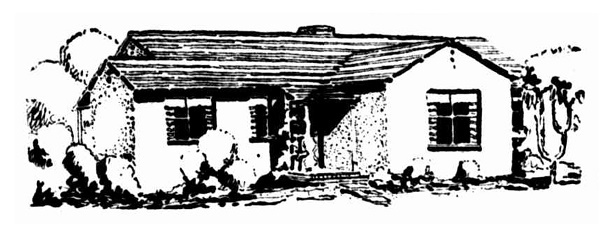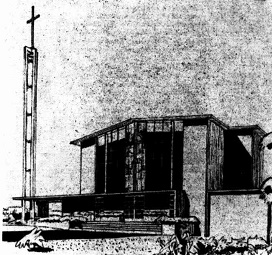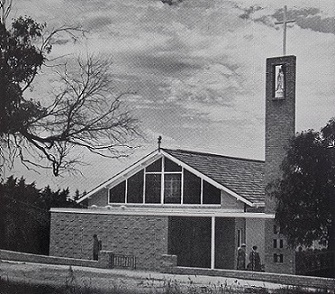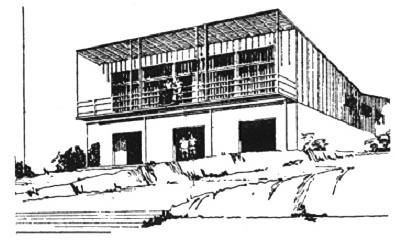Born
in Kew on 16 April 1908, Alan Gerard Robertson was the second son of Dr
Edward Robertson, chairman of the Health Commission of Victoria.
Staunchly
Catholic, the family were parishioners of Sacred Heart Church in
Cotham Road, Kew, and young Robertson completed his secondary education
at nearby Xavier College. His architectural career started in 1927, when he joined the office of Stephenson
& Turner. He remained there for seven years, during which time he
"gained considerable experience in the practice of his profession".
During that time, he also undertook studies in architectural
history, ornament and construction at the Melbourne Technical College.
Completing examinations for RVIA membership, he was admitted as an associate in August 1934. Four months
later, it was reported that Robertson intended to travel overseas,
visiting England and the Continent "for the purpose of developing
his architectural education".
Armed with a letter of introduction from the RVIA president to his counterpart at the RIBA, Robertson departed Melbourne in February 1935 aboard the Moldavia. Initially based in London, he obtained employment in the office of Wimperis, Simpson & Guthrie, where he worked under Leonard Rome Guthrie (1880-1958) on blocks of flats, office buildings and, most notably, a large residence for American socialite Barbara Hutton, who had just married Count von Reventhlow. Robertson remained in London for several years, during which time he recorded his observations in several letters home that were published in various Australian newspapers. In March 1937, he outlined his impressions of the recent Ideal Homes Exhibition in London, adding that he intended to travel to Paris soon afterwards to see the pavilions being built for the International Exposition. In January 1938, a report of recent travels through Austria and Italy included an anecdote about photographing the Colosseum and running into fellow Australian architect Tom O'Mahony, who was studying in Rome on a VASS scholarship. Travelling home via the USA, Robertson arrived in Melbourne in early 1939, after an absence of four years.
By March 1939, Robertson had commenced his own private practice, with a city office in the APA Building at 379 Collins Street. Almost immediately, he began to foster professional connections with the Roman Catholic church in Melbourne. In July 1939, he arranged an exhibition of what was described as "Catholic artwork", as part of the Campion Society's Spring School, held at his alma mater, Xavier College. In November, he published an article in the Catholic newspaper, the Advocate, entitled "Church Architecture", which discussed modern church buildings in Europe and illustrated an example in Budapest that he almost certainly photographed himself. Any further development of Robert's career, however, was waylaid by the Second World War. In December 1940, he enlisted with the Australian Army, serving with the 2/2 Motor Ambulance Company until he was discharged in November 1945 with the rank of Lieutenant.
Resuming civilian life as an architect, Robertson also re-ignited his earlier links with the Roman Catholic church. Taking advantage of the demand for new places of worship in developing areas in the immediate post-war era, he secured commissions for several churches including one at Bright (1951) and another at Mitcham (1952). The latter, which skilfully adapted a Quonset-like military hut, attracted much publicity. This seems to have cemented his reputation as a designer of churches. When he married in February 1952, he was referred to in one newspaper report as "a prominent Melbourne Catholic architect". His wife, formerly Miss Jean Elizabeth Kennedy, had been a nurse at the Mercy Hospital in East Melbourne, operated by the Sisters of Mercy. For the next twenty-five years, Robertson focused on ecclesiastical commissions that not only included countless churches and church additions, but also a range of other projects for Roman Catholic orders, schools (including his alma mater, Xavier College) and charitable organisations.
Robertson retired from practice in December 1977. His date of death is unconfirmed.
Armed with a letter of introduction from the RVIA president to his counterpart at the RIBA, Robertson departed Melbourne in February 1935 aboard the Moldavia. Initially based in London, he obtained employment in the office of Wimperis, Simpson & Guthrie, where he worked under Leonard Rome Guthrie (1880-1958) on blocks of flats, office buildings and, most notably, a large residence for American socialite Barbara Hutton, who had just married Count von Reventhlow. Robertson remained in London for several years, during which time he recorded his observations in several letters home that were published in various Australian newspapers. In March 1937, he outlined his impressions of the recent Ideal Homes Exhibition in London, adding that he intended to travel to Paris soon afterwards to see the pavilions being built for the International Exposition. In January 1938, a report of recent travels through Austria and Italy included an anecdote about photographing the Colosseum and running into fellow Australian architect Tom O'Mahony, who was studying in Rome on a VASS scholarship. Travelling home via the USA, Robertson arrived in Melbourne in early 1939, after an absence of four years.
By March 1939, Robertson had commenced his own private practice, with a city office in the APA Building at 379 Collins Street. Almost immediately, he began to foster professional connections with the Roman Catholic church in Melbourne. In July 1939, he arranged an exhibition of what was described as "Catholic artwork", as part of the Campion Society's Spring School, held at his alma mater, Xavier College. In November, he published an article in the Catholic newspaper, the Advocate, entitled "Church Architecture", which discussed modern church buildings in Europe and illustrated an example in Budapest that he almost certainly photographed himself. Any further development of Robert's career, however, was waylaid by the Second World War. In December 1940, he enlisted with the Australian Army, serving with the 2/2 Motor Ambulance Company until he was discharged in November 1945 with the rank of Lieutenant.
Resuming civilian life as an architect, Robertson also re-ignited his earlier links with the Roman Catholic church. Taking advantage of the demand for new places of worship in developing areas in the immediate post-war era, he secured commissions for several churches including one at Bright (1951) and another at Mitcham (1952). The latter, which skilfully adapted a Quonset-like military hut, attracted much publicity. This seems to have cemented his reputation as a designer of churches. When he married in February 1952, he was referred to in one newspaper report as "a prominent Melbourne Catholic architect". His wife, formerly Miss Jean Elizabeth Kennedy, had been a nurse at the Mercy Hospital in East Melbourne, operated by the Sisters of Mercy. For the next twenty-five years, Robertson focused on ecclesiastical commissions that not only included countless churches and church additions, but also a range of other projects for Roman Catholic orders, schools (including his alma mater, Xavier College) and charitable organisations.
Robertson retired from practice in December 1977. His date of death is unconfirmed.
Select List of Projects
| 1947 1951 1952 1953 1954 1956 1957 1960 1962 | Residence, Karnak Road, Ashburton Church of Our Lady of the Snows, Bright Church of St John the Evangelist, Whitehorse Road, Mitcham [mostly demolished] Presbytery for Church of St Patrick, Ford Street, Wangaratta Church of St Francis Xavier, Frankston Holiday house, Nepean Highway, Rye Church, Mount Beauty Church of Our Lady of Fatima, Lorne Classroom block at Brigidine Convent, Beechworth Office and residence for estate agent, Nepean Highway, Blairgowrie Church of St Bridget, Mordialloc Memorial boathouse for Xavier College, Yarra River, Hawthorn Church of Blessed Oliver Plunkett, Pascoe Vale Church of the Holy Eucharist, 1241 Dandenong Road, Malvern East |
 | |
| Residence, Karnak Road, Ashburton (1947) |
 | |
| Church of St John the Evangelist, Mitcham (1952) |
 | |
| Church of St Francis Xavier, Frankston (1953) |
 | |
| Church of Our Lady of Fatima, Lorne (1954) |
 | |
| Boathouse for Xavier College, Hawthorn (1957) |
